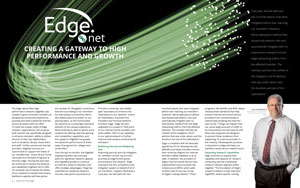The Edge optical fiber high-performance network, EdgeNet, was created to give connected members an exceptional connectivity experience, pushing past what traditional Internet service providers (ISP) can offer. To meet the unique needs of Edge member organizations, this purpose-built solution was specifically designed to enhance members’ ability to deliver services to their key stakeholders, such as students, faculty, researchers, and staff. “Unlike commercial Internet providers, EdgeNet services are custom-built to support the needs of our membership,” shares Bruce Tyrrell, Associate Vice President Programs & Services, Edge. “During the past year, we continued to expand the features and capabilities EdgeNet has to offer. For example, we increased the ability of our network to handle intercampus backbone capacity and have grown the number of 100 gigabit connections that we’re providing to our members for intercampus connectivity. We’ve also added Esports providers to our peering fabric, as this functionality has become an increasingly important element of the campus experience. Many institutions want to attract more students by offering real-time gaming and competition capabilities, and this update to EdgeNet has greatly increased the performance of these types of programs for colleges and universities.”
Over the last six months, the EdgeNet engineering team has executed plans for significant network capacity and capability growth to continue to meet the needs of members and offer strategic advantages. “Edge has extended our backbone footprint into two new points of presence at Princeton University, with added path redundancy to enhance the redundancy to our network,” shares Jim Stankiewicz, Associate Vice President and Principal Network Architect, Edge. “Edge has also upgraded to a couple of 100G ports to our Internet transit providers and we’ve added 100G circuit capability to our optical network to further improve intercampus connectivity for members.”
“Last year, we had well over two hundred attacks that were mitigated before ever reaching our members’ networks. We’ve deployed a method that dynamically detects risks and automatically mitigates with no intervention needed from the Edge networking staff or from the affected member. The member will then be notified of the mitigation, the IP address that was under attack, and the duration and size of the cyberattack.”
– Jim Stankiewicz

Bolstering Security and Mitigating Risk
Improving security and risk mitigation for members remain top-of-mind priorities as Edge further grows and enhances the network. “Edge maintains the DOS surveillance and mitigation system on behalf of all of our members,” explains Stankiewicz. “Last year, we had well over two hundred attacks that were mitigated before ever reaching our members’ networks. We’ve deployed a method that dynamically detects risks and automatically mitigates with no intervention needed from the Edge networking staff or from the affected member. The member will then be notified of the mitigation, the IP address that was under attack, and the duration and size of the cyberattack.”
Edge is compliant with the Mutually Agreed Norms for Routing Security (MANRS) and helps members ensure their American Registry for Internet Numbers (ARIN) database is up to date. In addition, the providers of Edge’s Internet transit service have implemented resource public key infrastructure (RPKI), which adds another level of security on top of Edge’s routing network. “These programs, like MANRS and RPKI, adopt industry-wide standards that help prevent Internet and transit service providers from unintentionally or intentionally breaking the Internet,” says Tyrrell. “Things can happen that can cause large amounts of traffic to be misrouted across the Internet and these two programs are designed to prevent those incidences from happening. As a service provider in the industry, following best practices is important to Edge and helps our members avoid service-related issues.”
Expanding Research Capabilities
Edge continues to expand their capability and capacity for research computing and has a dedicated research network segment within EdgeNet. “The foundation of Edge’s research network is their Internet2 GigaPOPs, where specific routing, switching, and an optical infrastructure are dedicated to the research leg of the network,” explains Stankiewicz. “This research network is physically and logically separated from the production network our members use today to get to the Internet.” Tyrrell adds, “Since the networks are logically segmented, any activity a researcher conducts on the research network that would commonly be disruptive in a normal environment will not affect our regular transport network.”
Edge has also been working with Rutgers University and Princeton to identify research network opportunities and create peering points with those networks, like the Eastern Regional Network (ERN). With a mission of building partnerships between research facilities, educational institutions, regional network providers, and Internet2, the ERN provides layered and transparent access to shared data and computing facilities for research projects.
At the end of last year, Edge, Rutgers, and Princeton began discussing how to migrate Edge’s internet connections away from the existing GigaPOP provider and create New Jersey’s first Internet GigaPOP in the state. Turned on in April of this year, the access point provides 200 gigabits of Internet2 capacity. “GigaPOP is a major interconnection point with Internet2, allowing members to connect with both national and international research assets,” explains Tyrrell. This access point also contains built-in flexibility for scale and growth, with the ability to grow to 400 gigabits in the future.
“Unlike commercial providers, EdgeNet, partners with our members to design and build optimal services that are custom designed to support their specific requirements. Edge also brings access to existing research entities, such as Rutgers University, Princeton University, New Jersey Institute of Technology, New York Presbyterian, and Hackensack Meridian Health—coupled with our peering capabilities built into the network—to connect with regional, national, and international research networks. EdgeNet is a one-stop destination for leading-edge support, research, and resources.”
– Bruce Tyrrell

Dedicated Support and Troubleshooting
The EdgeNet network supports 100 percent of member demand, where member’s traffic is never impacted by another member’s network activity. Designed with Internet transit providers and redundant nodes throughout New Jersey, EdgeNet delivers a highly available networking experience. “We’ve created a network that is highly reliable, highly available, and of high performance,” says Tyrrell. “In the event a member does experience an issue they believe is related to our network, we have several layers of ongoing support, including an Edge partner who is a managed services provider. They offer 24-hour monitoring management of the infrastructure. If they cannot resolve the issue, members have the ability to talk to our network engineers, which is very unusual in the industry. You can rest assured that you’ll be able to contact the right people to get any issues resolved.”
A new EdgeNet feature added this year is access to real-time network utilization reporting. Each Edge member receives a personal link to view their own connections and can provide additional visibility to an organization’s own network connections to the Edge network. “This feature helps members more efficiently troubleshoot inside and outside of their network when they’re experiencing a problem,” says Tyrrell.
Superior Network Connectivity
As one of the premier educational research networks in the country, EdgeNet offers a myriad of options for research networking. “Unlike commercial providers, EdgeNet partners with our members to design and build optimal services that are custom designed to support their specific requirements,” says Tyrrell. “Edge also brings access to existing research entities, such as Rutgers University, Princeton University, New Jersey Institute of Technology, New York Presbyterian, and Hackensack Meridian Health—coupled with our peering capabilities built into the network—to connect with regional, national, and international research networks. EdgeNet is a one-stop destination for leading-edge support, research, and resources.”
For research organizations who are looking to connect with other institutions, pursue larger grant opportunities, and meet their needs of high-speed research and collaboration, EdgeNet can help pave the way. Discover the power of EdgeNet at NJEdge.net/solutions-overview/network-connectivity-and-internet2/.



